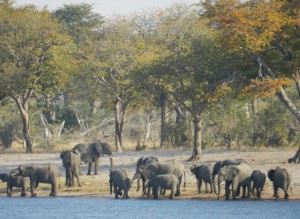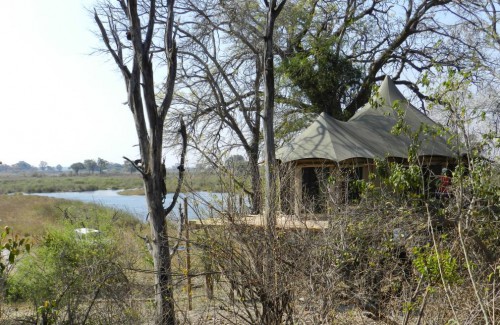18th September 2014 Windhoek, Namibia
Caprivi connections
Last month I was fortunate enough to travel up to the extreme north east of Namibia to visit the Zambezi Region and catch up with some innovative UK-funded conservation and tourism projects taking place there.
The region gained its new name in August 2013 but is still probably better known internationally by its former name: the Caprivi Region or Caprivi Strip. It juts out as a narrow finger of land bordered by the Okavango, Kwando, Chobe and Zambezi rivers. Angola and Zambia lie to its north and Botswana to the south. It is a truly unique confluence of geographical features and national boundaries. Rich in wildlife, it serves as a corridor for African elephant moving from Botswana and Namibia into Angola, Zambia and Zimbabwe.

The region is also the birthplace of Namibia’s innovative conservancy management model, which was initiated in Caprivi (as it was then) in 1999 with World Wildlife UK support and has since spread across the country. The model gives rural communities ownership and control over the wildlife in their territories to ensure local people are invested in conservation and wildlife, and extensive community-based natural resource management programmes have been set up. The government and international conservation organisations provide funding to the conservancies, who also partner with tourism operations, like lodges and tour operators, to become self-sustaining. The resources generated help cover local education and medical needs, like HIV-AIDS prevention and treatment, and compensation is paid towards livestock loss from predators. Conflicts between human settlements and wildlife still exist but are limited and compensated for.
There are currently 14 conservancies in the Zambezi region, with a further two recently approved, and 79 nationwide. A lot of UK funds have been pumped in to help support the development of this model, including historic DFID UK Aid programmes and UK Lottery funds, which recently donated to the local implementing organisation that has helped lead the process: Integrated Rural Development and Nature Conservation (IRDNC).
I was able to spend a fascinating day with IRDNC staff in the Zambezi region, visiting the Mashi Conservancy and meeting with their community committee members, game guides and tourism coordinator.

They updated me that the introduction of the conservancy model has supported a marked increase in local game (wild animal) numbers now that communities value them as commercial assets and tourism draws. However, the increase in animal numbers and wealth in rural areas has attracted greater numbers of people into the region, resulting in higher incidents of human wildlife conflict as elephants raid crops planted along traditional animal corridors and more people get attacked by hippos and crocodiles whilst accessing the Kwando River. Specially trained conservancy game rangers work closely with government wildlife officers and special police units to help manage these intertwined relations and control local poaching, which is sadly on the rise. (I will report back soon on our support to separate local initiatives to tackle this challenge.)
Interestingly, reports on the success of the conservancy model vary wildly depending on who you talk to in the region. Most agree that it has resulted in improvements in rural poverty levels but even local conservancy committee members admit that some communities spent early dividends quickly and unwisely, and efforts to set up community management programmes to build up infrastructure are seeing slow progress. Everything seems to hinge on the strength and motivations of the conservancy committees. Those with poor management and weak structures can undercut any meaningful uplifting of their communities’ lives. Efforts are now underway to engage neighbouring governments, who all differ in approach to local ownership of conservancies.
Overall, the success of the model has bolstered Namibia’s international credentials as a young democracy with sound wildlife conservation policies. Namibia was the first African country to incorporate the protection of the environment into its Constitution and the World Wildlife Fund has dubbed its innovative approach “a success for people and wildlife”. In addition to empowering its communities with rights to manage and benefit from the country’s wildlife through communal conservancies, the government has protected its land and coast by setting aside more than 40% of its land as reserves and parks – including the famed Etosha National Park and vast Namib-Naukluft National Park – and its entire coastline is also protected.

During my visit I was also able to pay a visit to an equally innovative guide training venture in the Bwabwata National Park, run by African Monarch, who the High Commission supported last year to help accelerate the Namibian guide registration process and upskill locals to become professional game guides. African Monarch is now expanding its activities and establishing a new guide training camp at the Nambwa Campsite in the park.